4 Steps to Choose the Perfect Niche for Your Blog

The number one question I get asked from new bloggers (by a landslide) is:
How do I choose my niche?
Here’s the simple truth:
The odds of choosing the perfect niche when you’re just starting as a beginner are infinitesimally small.
Think about it.
People typically start a blog, write about something they’re passionate about, and then get burned out when it’s not making money.
If you want to start a true blogging business, you need to choose your niche not based on passions, but on four primary business factors:
- Audience Revenue Potential
- Affiliate Marketing Potential
- Professional Leverage
- Keyword Research
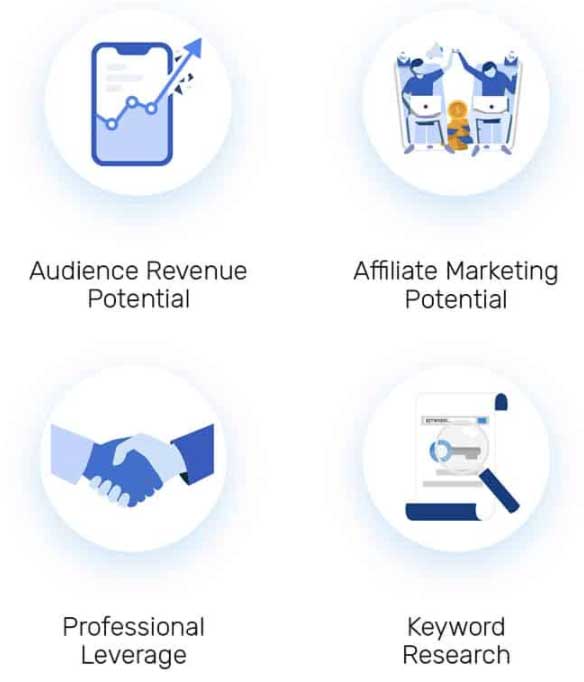
1. Audience Revenue Potential.
When you’re starting a new blog, the most common question is, “What should my niche be?”
The key is to find an area that you understand and solve a pain point for your audience.
However, you not only need to solve a pain point – you need to solve a pain point that an audience is willing to spend money on.
As a blogger, you need to understand your audience’s challenges deeply so that you can offer them exactly what they need.
And the best place to start is by looking at yourself.
Ask yourself, “What audiences am I a part of?”
You’re far more likely to understand a specific group’s struggles if you’ve encountered them yourself.
Take my blog, for example.
When I started this blog, I was a 31-year old American male working in the tech industry.

I was putting in long hours, sacrificing time with my family and friends, and getting stressed and burned out by the rat race.
So I created this blog as a means to an end – a way to make passive income, escape my 9-5 and take back control of my time – and my life.
So my target audience was people similar to me:
- 25-45 years old.
- Working 9-5 but want to escape the rat race.
- Ready to hustle and put in the work.
- Smart and technically savvy.
- People who want to make passive income through a blog.
Understanding your audience is the first step.
The second (and equally important) step is to understand how much your audience is willing to spend to solve their pain points.
This is your audience revenue potential.
This bears repeating: you need to understand your audience AND how much they’re willing to spend on your solution.
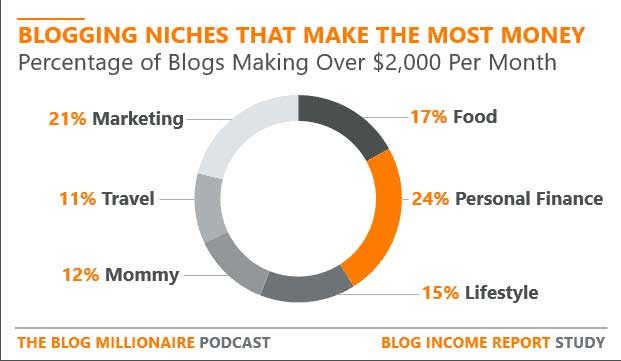
Source: successunscrambled.com
For example, let’s say you’re planning to start a blog about human resources and job tips for Millennials.
Your blog posts may pull in different types of readers, including job seekers, working professionals, and college students.
To monetize a blog in this niche, let’s say you create a sales funnel:
- You write new content to attract an audience online.
- Next, you build a “job interview checklist” lead magnet to generate email opt-ins.
- Third, you place affiliate links to some products you want to promote.
- Finally, you offer a $300 product titled “The Ultimate Job Interview Preparation Online Course.”
Nothing is wrong with this approach.
This tends to be a common approach for most new bloggers. If you were to put in a few years of content creation and building up your email list, I estimate you could start making a passive income in 2-3 years.
However, by slightly altering your potential niche, you drastically increase your blog’s income potential.
All you do is change your target audience from job seekers to job employers.
Let me explain.
By adding a B2B component to your blog, you shift your audience from individuals to businesses.
Businesses have larger bank accounts and are more likely to pay you without hesitation.
The beautiful thing about this approach is that your blog launch, content, and marketing funnel are pretty much the same. However, with the B2B component, you don’t just stop at a $300 course. You can add the final component of 5-figure online consulting.
Rather than writing a blog post on entry-level interview tips, position yourself as an expert and go after the businesses themselves by offering something like HR audits or onboarding consulting for thousands of dollars per month.
When you’re just starting out and traffic is hard to come by, offering consulting services is a great way to generate more income with less traffic.
It’s simple math: If your new blog has 100 visitors a 2% conversion rate, your two sales should be for thousands, not $19.99.
Instead of focusing on adding affiliate links and ads to your site when you have little traffic at the beginning, see if you can come up with a high-end consulting offer to build momentum and make money right out of the gate.
Remember, just understanding your audience’s pain points isn’t enough.
To improve your revenue potential, a portion of your audience needs to be in a lucrative business niche and pay on a monthly recurring basis.
With this approach, I hope you’re beginning to understand why I truly believe you can make $10,000/month in 90 days with a new blog.
These new funds will be used to accelerate your path to passive income, but we’ll leave it at that for now.
Let’s move onto something I’m very passionate about – affiliate marketing.
2. Your Niche Needs Affiliate Marketing Potential.
Affiliate marketing is my favorite form of blog monetization. It’s the most passive, and once you start getting traffic, you can make money while you sleep.
Affiliate marketing is the act of recommending products and services of other businesses and making a commission on every sale.
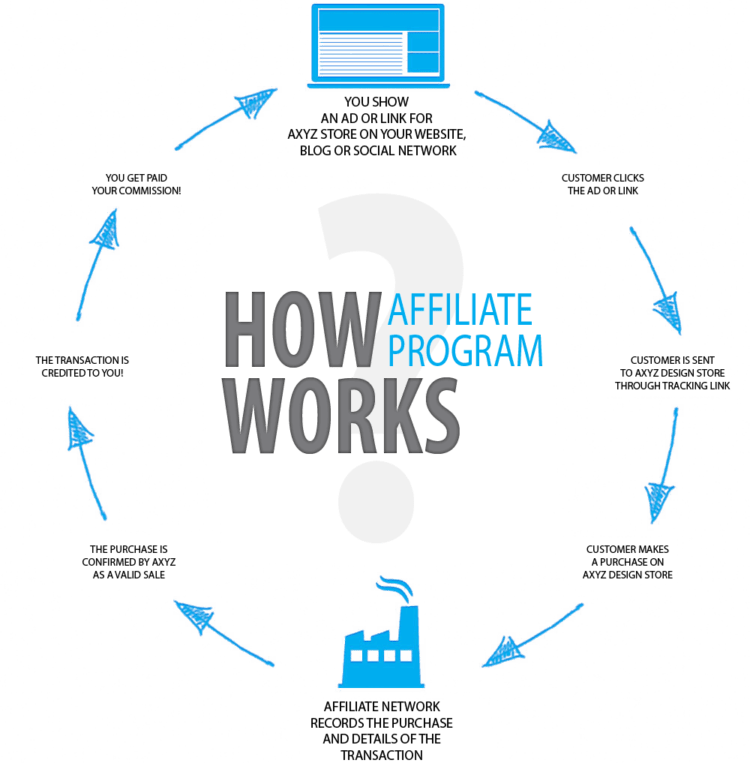
Source: affiliatemarketingtraining.com
Most large companies have affiliate programs you can join. Once you apply and are approved into their programs, you can grab your unique affiliate links to add to your blog, view reporting on clicks and sales, and see any future payouts you’re scheduled to receive.
Here are some steps to get started with affiliate marketing:
- Apply to a company’s affiliate program either on their site or in an affiliate network. For this, you’ll need a website and an email address from your domain – not just a Gmail or Yahoo email.
- Once approved, grab your unique affiliate link and copy/paste it into any piece of text on your blog.
When a user clicks that specific link, a cookie is stored in their computer, which credits the sale to you based on the cookie duration – typically 30, 60, or 90 days.
Now, when you think of the word blogging, what comes to mind?
- Maybe it’s lifestyle blogging and writing about what they’ve been purchasing for their family lately.
- Or a blogger that’s giving you some great advice on how to lose weight while promoting fitness affiliate programs.
- It could even be an interesting person writing their own personal memoirs.
I want you to forget about these types of blogs.
They may be interesting to read, but they aren’t the niches that will bring you the most revenue.
Instead, consider this simple formula.
- To make a lot of money blogging, you need affiliate income.
- To make affiliate income, you need to rank on search engines and get web traffic.
- To get web traffic, you need to rank for keywords that drive the most affiliate revenue.
So what are these keywords?
The answer: keywords with the word “best” in them.
Here are some examples:
- In finance, it could be the best credit cards, best auto loans, or best home insurance.
- In tech, the keywords could be the best laptop of 2020, best VR headsets, or best Mac accessories.
- In marketing (like my blog), it could be the best email marketing software, best web hosting, or the best website builders.
- In travel, keywords could include the best travel insurance or best coworking spaces.
These “best” keywords are searched by people looking for product reviews.
They want to read a blog with in-depth content on the “best” something before making a purchase (and they aren’t ready to go right to a company’s website and buy something yet.)
Think about it.
If you’re searching for a new laptop, you might type in “best laptop of 2020.”
Google this term right now and look at the top 10 results.
Every single website in the top 10 results is an affiliate. Notice how there are no actual companies selling laptops.
There’s no Best Buy, Walmart, Dell, or HP – only affiliates that might use these sites’ affiliate programs to recommend laptops (side note: check out this post on Walmart’s affiliate program to learn more about the millions of products on offer).
Now try Googling “best credit cards.” What do you see?
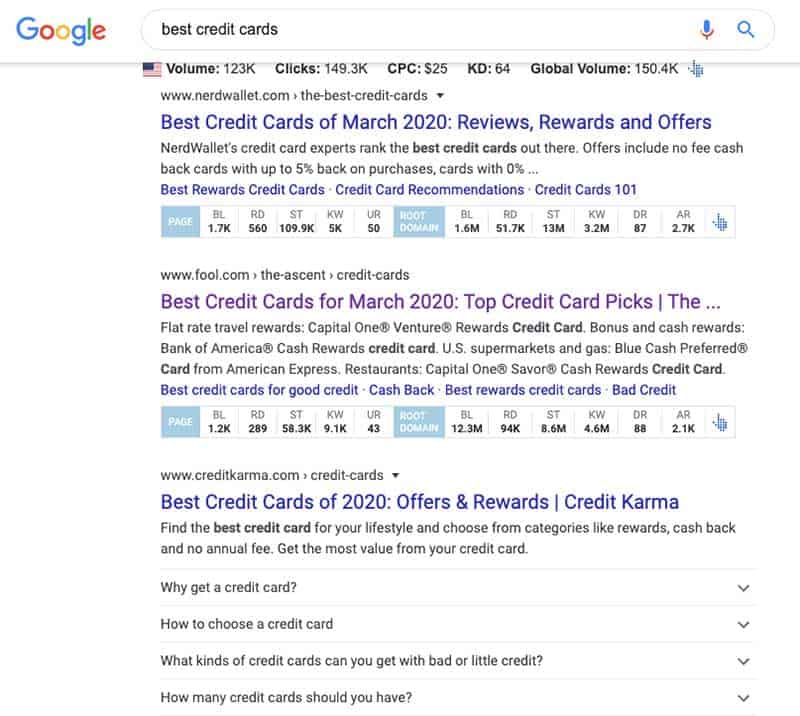
Again, every single top 10 result is an affiliate blog.
Why do these affiliate sites outrank brands selling the products?
They write long-form, in-depth review articles that search engines (and readers) prefer.
In fact, 49% of consumers depend on influencer reviews and recommendations.
You’ll begin to realize is that most profitable blogs are, in fact, review websites making affiliate commissions from list posts.
And the truth is, these recommendations are primarily based on how much money the affiliate blog is making from their top recommendations – not the actual quality of the product itself.
Once you grasp this when you learn how to start a blog, you’ll begin to see affiliate sites everywhere.
So now when you think of blogging and planning your niche, replicate sites like these:
- Finance: NerdWallet, Fool.com, WalletHub, CardRatings.
- Tech: Tom’s Guide, Techradar, Wire Cutter, CNET.
- Travel: Nomadic Matt, The Points Guy, Expert Vagabond.
- Business: The Balance SMB, FitSmallBusiness, FinancesOnline.
I think that the most profitable niches right now for new blogs are finance, tech, travel, business, and marketing.
But there are tons of other options.
We’ll get to keyword research later, but know that your blog should have affiliate marketing revenue potential.
Let’s move onto the next weapon in your blogging arsenal – your professional leverage.
3. Use Your Professional Leverage.
After uncovering a lucrative audience to provide value to, the next step of learning how to start a blog is uncovering your strategic advantages.
Ask yourself:
- What is my current level of professional experience?
- What connections do I have in my industry?
- Can I leverage this experience into a profitable blog?
- If I could pitch any website in the world to contribute a guest post, who would choose me from the start?

Source: linkedin.com
To build a truly successful blog, you first need to build influence.
And to build influence, you need to step outside of your comfort zone and leverage your connections, professional experience, and everything at your disposal like never before.
With a blog, you’ll also be performing a lot of outreach to make new connections. This includes building relationships so you can guest post on authoritative sites in your niche to get relevant, high Domain Authority (DA) backlinks.
And when you’re just starting, you may not have many connections or published content out there. You might say: “Why would anyone feature me?”
This is where leveraging your professional background helps tremendously.
For example, if you’re a photographer, you might have a base of clients, contacts from local meet-up groups, and even know photography influencers that you met in the past. If you can leverage these contacts in the future, you can accelerate the growth of your blog.
Use every advantage you have at your disposal. These advantages will help you build early momentum with guest posts, backlinks, and social shares.
Now let’s move onto the final (and most important) factor in choosing your niche.
4. Keyword Research.
To me, keyword research is the most important step when choosing your blog’s niche.
It’s very simple. Are people searching for the things you want to write about?
Every individual blog post needs to focus on one target keyword. And if no one is searching for it, you’ll never get traffic.
It’s a fact: You need to have a basic understanding of keyword research and search engine optimization (SEO) so that your blog can rank and get traffic.
Why?
People are online six and a half hours a day.
People search Google 63,000 times every second. That’s 3.8 million searches per minute, 228 million searches per hour, and 5.6 billion searches per day.
Plus, organic traffic from search engines is way more valuable than social media traffic. Rather than aimlessly browsing the web, people perform high-intent searches to discover solutions to their problems.
The good news is that there are SEO tools to understand all of this search data. With tools like SEMRush and Ahrefs, you can view individual keyword metrics, including:
- Monthly search volume: how many times a keyword is searched for in a given month.
- Keyword difficulty: on a scale from 0 to 100, how difficult is it to rank for that keyword based on the competition.
- The average cost per click (CPC): this is how much the keyword is worth if you were to create a PPC ad for it and pay for the click. It’s a good indicator of the keyword’s value.
So what do you look for?
You want to find keywords with high volume and low competition.
Here’s how I rate these competitive metrics.
Monthly Search Volume:
- 0-1,000: Low
- 1,000-5,000: Low/Medium
- 5,000-20,000: Medium
- 20,000-100,000: High
- 100,000+: Very High
Keyword Difficulty:
- 0-20: Low
- 21-50: Medium
- 51-75: High
- 76+: Very High
On my site, there are two main types of keywords I target when it comes to SEO: high-volume/high competition and medium volume, low competition.
1. Revenue Drivers: Medium Volume, Low Competition, High CPC Keywords
The first keywords new blogs should search for are medium volume, low competition keywords.
For example, let’s take a look at my post on Webinar Software. I published this post and became #1 for this keyword within four months.
- Target keyword: webinar software
- Monthly search volume: 4,300
- Keyword difficulty: 22
- Average CPC: $25.00
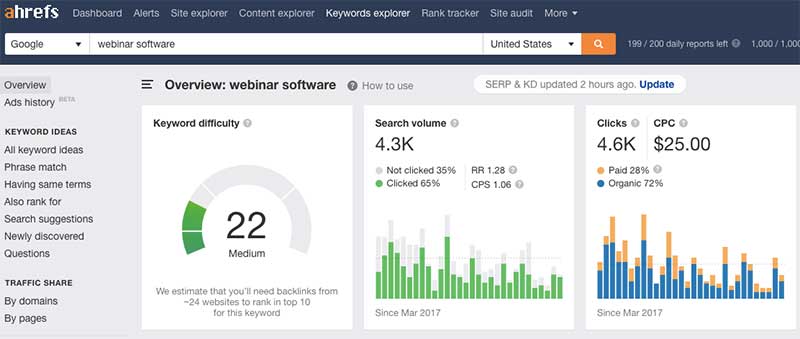
4,300 is not a very high monthly search volume, but since position 1 gets over 33% of traffic, I could expect to get 1,419 visitors/month to my blog for position one on this term.
Plus, with a low keyword difficulty of 22, this term should be relatively easy to rank for (in fact, I got to page 1 just a few days after publishing the blog post).
Finally, with an average CPC of $25, it is a valuable, high-intent search term.
One quick side note on keyword search volume:
While the keyword webinar software gets 4,300 searches per month, there are thousands of potential variations of this keyword – for example, best webinar software, webinar tools, webinar platforms, etc. This post can rank for all of these variations, too, so I typically double or even triple my volume estimates based on the main target keyword.
Pro Tip:
Using Ahrefs Also Rank for Report, you can view keywords that the top-ranking pages for your target keyword also rank for in the top 100 search results. This allows you to find less obvious keywords that you can also include in your post’s copy and subheadings.
The key to finding relevant keywords from this report to use for your blog is to search with more specific queries. For example, instead of “cooking,” use “vegan recipes.” Or “email marketing services” instead of “marketing.”
How to find this type of keyword for your blog:
Use a tool like Ahrefs and filter the results. Set the monthly search volume filter to a minimum of 1,000 and the Keyword Difficulty filter to a maximum of 50.
What these keywords are good for:
These keywords should make up the bulk of your posts and be the main revenue-drivers for your blog. The key is to find a good amount of long-tail keywords with medium volume and low competition in your niche.
If these keywords are preceded by terms like “how to” and “best,” you’re well on your way to finding a profitable niche and solving a pain point.
2. Blog Builders: High-Volume/Medium-High Competition
The second type of keywords that I target are super high-volume terms that aren’t as easy to monetize but can bring in a lot of traffic.
For example, take my post How to Make Money Online.
- Target keyword: how to make money online
- Monthly search volume: 103,000
- Keyword difficulty: 55
- Average CPC: $2.00
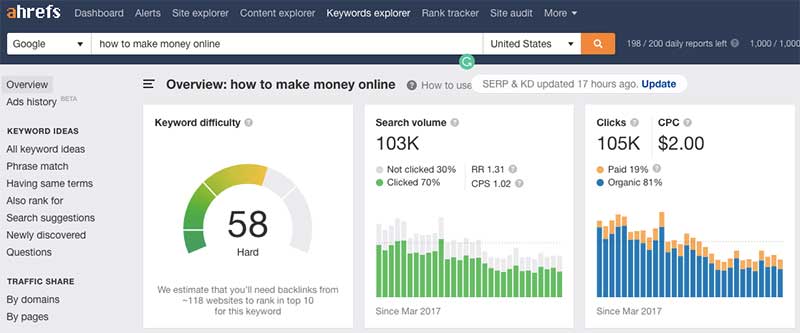
First, this keyword has a 25x higher volume than webinar software. With high volume and all of the potential keyword variations, ranking in the top 5 positions for this term could bring in 30-65,000 visitors/month.
However, this keyword also has a lower search intent than webinar software. With the keyword webinar software, we know what the searcher wants.
With how to make money online, this user could be interested in anything from starting an online business to podcasting or coupon clipping – we just don’t know.
So that’s why it’s average CPC is only $2.00 – it’s vaguer and harder to monetize. However, this keyword can pull in lots of traffic and get readers to click your other higher-revenue blog posts.
How to find this type of keyword for your blog:
Use a tool like Ahrefs and filter the results. Set the monthly search volume filter to a minimum of 20,000 and the Keyword Difficulty filter to a maximum of 75.
What these keywords are good for:
These keywords should make up 5-10 pillar blog posts that you put a lot of time and effort into. While these high volume keywords won’t generate immediate revenue, they bring in a ton of traffic to your blog and can increase the size of your email list.
3. Summing Up Keyword Research
A blog needs a mix of both high volume keywords and high intent keywords.
This entire strategy comes into play when planning your blog’s first five posts. For example, a few posts should be large how-to guides with high search volume to bring in readers. And a few other posts should be low volume/high intent keywords that can be monetized.
Here are some of the tools you can use for your keyword research:
- SEMrush
- Ahrefs
- Google Keyword Planner
Wrapping Up Picking Your Niche.
Your niche needs audience revenue potential, affiliate marketing potential, professional leverage, and keyword research.
Choosing a profitable niche will save you countless hours of time and wasted energy. This early planning is one of the most important keys to blogging success.
Further reading on AdamEnfroy.com: The niches you can go with are endless, but the most important thing is that you do your research and come up with a topic that works for you.
Here are some specific articles to help you get started:





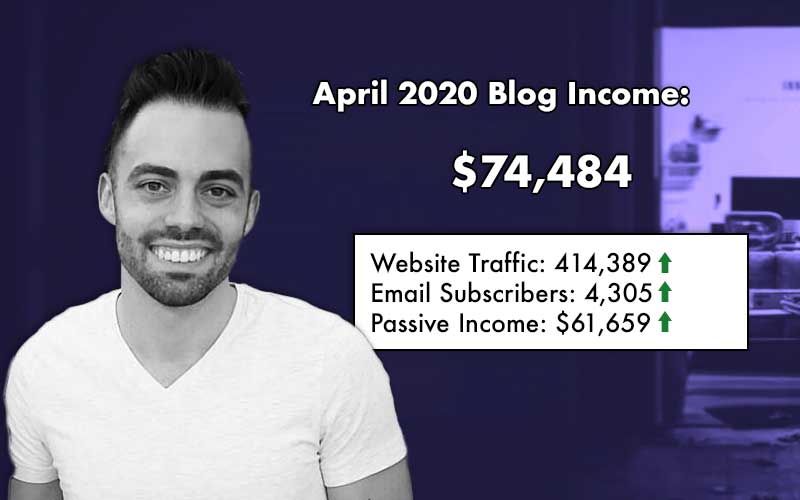
Hi Adam, I just wanted to say thank you. I loved this post. It is a great resource for someone who’s just starting to understand how much hard work can be but rewarding to make money with a blog in the right niche, with the right audience and tools.
Glad you liked it – thanks!
Blogging while it isn’t talked about as the “dominating” marketing trend right now… Is still so dominate and great at generating leads, customers, and authority. That’s why we often go after the same kind of mix of keywords that you described. Some high volume, some low competition, it’s a mix. Great article Adam!
Thanks Jon!
It’s a very useful article as always. Thanks Adam, a quick refresher to jump into keyword research 🙂
Thank you for all the info you provide! You have been such a great help for me who is just starting out.